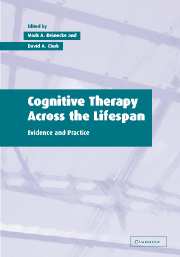Book contents
- Frontmatter
- Contents
- List of contributors
- Foreword
- 1 Cognitive therapy across the lifespan: conceptual horizons
- 2 Cognitive theory and therapy of depression
- 3 Cognitive theory and therapy of bipolar disorders
- 4 Regulation of emotion in generalized anxiety disorder
- 5 Cognitive theory and therapy of obsessions and compulsions
- 6 The cognitive model of panic
- 7 Treating obsessional problems using cognitive-behavioral therapy
- 8 Narcissistic personality disorder
- 9 Cognitive therapy and the self
- 10 Promoting cognitive change in posttraumatic stress disorder
- 11 Cognitive theory and therapy of social phobia
- 12 The cognitive model of bulimia nervosa
- 13 Cognitive therapy and schizophrenia
- 14 Cognitive-behavioral interventions for alcohol abuse and dependence
- 15 Cognitive approaches to understanding, preventing and treating child and adolescent depression
- 16 Cognitive-behavioral interventions in childhood anxiety disorders
- 17 Attention deficit/hyperactivity disorder
- 18 Cognitive-behavioral interventions for children with conduct problems
- 19 Processes of change in cognitive therapy
- 20 Cognitive therapy in the twenty-first century: current status and future directions
- Index
5 - Cognitive theory and therapy of obsessions and compulsions
Published online by Cambridge University Press: 05 July 2014
- Frontmatter
- Contents
- List of contributors
- Foreword
- 1 Cognitive therapy across the lifespan: conceptual horizons
- 2 Cognitive theory and therapy of depression
- 3 Cognitive theory and therapy of bipolar disorders
- 4 Regulation of emotion in generalized anxiety disorder
- 5 Cognitive theory and therapy of obsessions and compulsions
- 6 The cognitive model of panic
- 7 Treating obsessional problems using cognitive-behavioral therapy
- 8 Narcissistic personality disorder
- 9 Cognitive therapy and the self
- 10 Promoting cognitive change in posttraumatic stress disorder
- 11 Cognitive theory and therapy of social phobia
- 12 The cognitive model of bulimia nervosa
- 13 Cognitive therapy and schizophrenia
- 14 Cognitive-behavioral interventions for alcohol abuse and dependence
- 15 Cognitive approaches to understanding, preventing and treating child and adolescent depression
- 16 Cognitive-behavioral interventions in childhood anxiety disorders
- 17 Attention deficit/hyperactivity disorder
- 18 Cognitive-behavioral interventions for children with conduct problems
- 19 Processes of change in cognitive therapy
- 20 Cognitive therapy in the twenty-first century: current status and future directions
- Index
Summary
Introduction
Obsessive-compulsive disorder (OCD) is one of the major anxiety disorders in the fourth edition of Diagnostic and Statistical Manual of Mental Disorders (DSM-IV: American Psychiatric Association, 1994). The disorder is characterized by persistent obsessions and compulsions that are time-consuming or cause marked distress or impairment and are perceived by the patient to be excessive or unreasonable. Obsessions are intrusive, recurrent, and persistent thoughts, images, or impulses that are unacceptable, unwanted, and usually associated with subjective resistance (Rachman and Hodgson, 1980). The content of the obsession is egodystonic in that it deals with themes that are inconsistent or even alien to one's sense of self, values, or usual ways of behaving (Purdon and Clark, 1999). Because of this the occurrence of the obsession is highly distressing for individuals with OCD, even though they may acknowledge that the intrusion is senseless and irrational (Rachman and Hodgson, 1980). The most commonobsessions involve concerns about dirt/disease contamination, accidents, unintended aggression or violence towards others, inappropriate sexual acts, mistakes, doubt, blasphemous thoughts, orderliness and symmetry, and hoarding.
Compulsions are repetitive, stereotypic, and intentional behavioral or mental responses that are subjectively experienced as an urge or pressure to act. The OCD patient may view the compulsion as excessive or exaggerated but the urge to act is not necessarily resisted in all cases. Compulsions are usually triggered by the occurrence of a distressing obsession.
- Type
- Chapter
- Information
- Cognitive Therapy across the LifespanEvidence and Practice, pp. 90 - 116Publisher: Cambridge University PressPrint publication year: 2003



